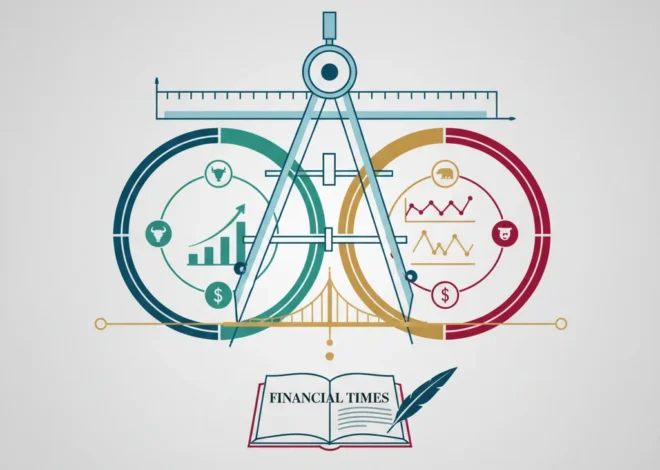
Geopolitics on the Menu: NATO’s Defense Overhaul and the Economic Tremors of Trade Tensions
In an era once defined by an unwavering march toward globalization, the tectonic plates of international relations are shifting. The global stage is no longer solely directed by economic incentives and free-market principles. Instead, a powerful, older script is re-emerging: one of geopolitical strategy, military posturing, and national interest. This pivot is forcing investors, business leaders, and financial professionals to recalibrate their playbooks, understanding that a headline from a defense summit can now move the stock market as profoundly as an interest rate decision.
Two seemingly disconnected events, highlighted in a recent Financial Times report, perfectly capture this new reality. In Brussels, NATO allies are deep in debate over how to forge a more muscular defense posture in response to Russia’s persistent probing. Simultaneously, across the Atlantic, a potential trade dispute simmers, with former President Trump’s praise for Italian Prime Minister Giorgia Meloni clashing with the looming threat of tariffs on iconic Italian exports. Together, these narratives paint a vivid picture of a world where military alliances and trade relationships are intertwined, creating a complex web of risks and opportunities that the modern investor cannot afford to ignore.
The New Iron Curtain: NATO’s Multi-Trillion Dollar Realignment
For decades following the Cold War, many Western nations cashed in a “peace dividend,” redirecting funds from military budgets to domestic programs. That era is definitively over. Russia’s actions in Eastern Europe have served as a stark wake-up call, forcing the North Atlantic Treaty Organization (NATO) to confront its most significant strategic challenge in a generation. The core of the current debate revolves around a fundamental question: What is the real price of security?
The alliance is grappling with how to “beef up defences,” a deceptively simple phrase that conceals a monumental undertaking in finance, logistics, and industrial policy. The long-standing, and often ignored, guideline for members to spend at least 2% of their GDP on defense is no longer an aspiration but a baseline necessity. For many European nations, meeting this target requires a seismic shift in national budgeting, representing hundreds of billions of dollars in new annual spending.
This reallocation of capital carries profound implications for the European economy. It’s a classic “guns versus butter” dilemma on a continental scale. Every euro directed towards tanks, ammunition, and advanced cyber-warfare capabilities is a euro not spent on healthcare, education, or green energy infrastructure. This will force difficult political choices and could impact sovereign debt markets as nations potentially increase borrowing to fund their rearmament.
To illustrate the scale of this commitment, consider the defense spending of several key NATO members relative to the 2% target.
| NATO Member | Estimated Defense Spending (% of GDP) | Status vs. 2% Target | Economic Implication |
|---|---|---|---|
| Poland | ~4.2% | Exceeds | Major investment in defense sector, potential strain on other public services. |
| United States | ~3.5% | Exceeds | Sustained high spending, driving innovation in defense technology. |
| Germany | ~2.1% | Meets (Recent) | Significant budgetary shift after years of under-investment. |
| France | ~1.9% | Slightly Below | Pressure to increase spending, balancing with domestic priorities. |
| Italy | ~1.7% | Below | Facing calls to increase contributions amidst economic challenges. |
| Canada | ~1.4% | Below | Ongoing political debate about meeting alliance commitments. |
Note: Figures are illustrative estimates to demonstrate the variance within the alliance.
For investors, this trend is creating a clear sectoral shift. Aerospace and defense stocks have already seen significant appreciation, and this is likely to continue. The investment is not just in traditional hardware; it’s also in next-generation financial technology (fintech) for secure military procurement, advanced cybersecurity to protect critical infrastructure, and even exploring blockchain for resilient and transparent supply chain management for military logistics. The sheer scale of this rearmament will ripple through the entire industrial base, from raw material suppliers to high-tech software firms.
From Pasta to Policy: The Unpredictable Dance of Trade and Diplomacy
While NATO plans for large-scale conflict, another form of friction is brewing in the realm of international trade, reminding us that economic and military security are deeply linked. The dynamic between former President Trump and Italy’s leadership offers a compelling case study. On one hand, Trump has been vocal in his praise for Prime Minister Meloni, as noted in the FT’s mention of his comments on her memoir (source). On the other, his “America First” doctrine has consistently included the threat of broad tariffs, with the Italian pasta industry being a potential target.
This juxtaposition highlights the unpredictable nature of modern diplomacy, where personal rapport can be decoupled from hard-nosed trade policy. For Italy, and the EU at large, this creates a challenging environment. How do you plan for long-term investment and trade when the rules can be rewritten based on the political winds in a key partner nation? Tariffs are a blunt instrument in economics. A tariff on Italian pasta isn’t just a tax on a beloved food item; it’s a direct blow to an entire ecosystem of farmers, manufacturers, distributors, and exporters. It would raise prices for American consumers, create supply chain disruptions, and almost certainly invite retaliatory tariffs from the EU on American goods, escalating a trade skirmish into a broader economic conflict.
This uncertainty has a chilling effect on business investment and complicates the world of international banking and finance. Companies planning cross-border expansions or acquisitions must now factor in a much higher degree of political risk. The cost of capital can rise, and supply chain diversification becomes not just a good idea but an essential survival tactic. The smooth, predictable flow of goods and capital that underpinned decades of prosperity is no longer a given.
An Investor’s Guide to the New World Order
So, how should finance professionals, business leaders, and investors navigate this complex and volatile landscape? The old rules may not be broken, but they certainly need updating.
- Integrate Geopolitical Analysis: Macroeconomic analysis is no longer enough. Understanding the political motivations of state actors, the stability of alliances, and the potential for conflict is now a crucial part of any robust investing thesis. This means following defense policy and trade negotiations as closely as central bank statements.
- Focus on Resilient Sectors: Industries essential to national security and sovereignty are likely to see sustained support. This includes not only defense and aerospace but also cybersecurity, energy independence (including renewables and nuclear), and domestic food production. The ability to withstand external shocks is becoming a prized corporate attribute.
- Diversify Geographically and Thematically: The era of concentrating investment in a few “stable” regions may be ending. A truly diversified portfolio should now consider exposure to different geopolitical blocs and themes. This includes investing in the companies and technologies that enable resilience, such as advanced logistics, supply chain management software, and even novel trading platforms that can adapt quickly to new tariff regimes.
- Monitor the Intersection of Technology and Security: The next frontier of conflict and competition is digital. The development of artificial intelligence, quantum computing, and fintech solutions will have profound security implications. Companies leading in these fields represent both a significant investment opportunity and a strategic asset for their home nations, making them focal points of geopolitical interest.
The convergence of NATO’s strategic rethink and the simmering US-EU trade tensions is not a coincidence. It is a symptom of a broader global realignment away from cooperative economics and towards competitive security. The global economy is becoming a contested space, and the rules of engagement are being rewritten. For those who can read the signs and adapt, this new era will present immense opportunities. For those who cannot, the risks have never been greater.
Ultimately, the discussions happening within NATO’s headquarters and the political maneuvering over trade policy are two sides of the same coin. They signal a world where strategic autonomy, military strength, and economic resilience are paramount. The financial markets are simply the arena where the consequences of these high-stakes decisions will play out.


